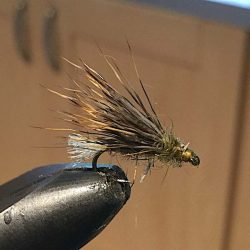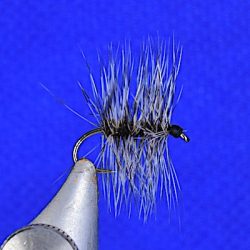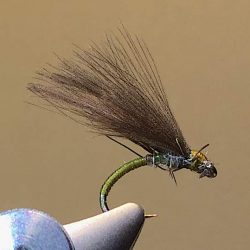How to fish the Hollybush Pool on the Welsh Dee at Llangollen
Introduction
Would like to know how to fish the Hollybush Pool on middle beat of Llangollen-Maelor Angling club.
If Yes…
You’ll definately find this fly fishing guide very useful and informative.
This guide condenses years of experinece fly fishing the Hollybush Pool. On working through it, you will learn the different approaches I empoly for catching grayling, brown trout, and sea trout.
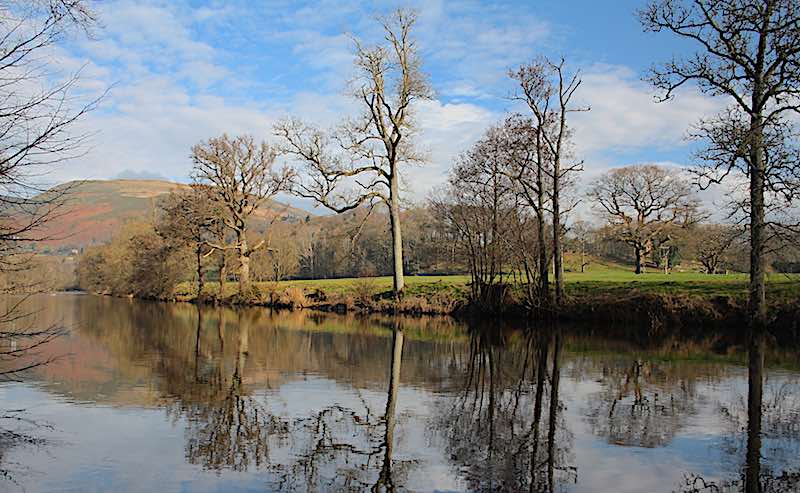
How to get to the Hollybush Pool?
The Hollybush Pool is a long pool that is located between directly above Duncan’s Pool on Llangollen-Maelor’s middle beat of the Welsh Dee.
The right bank is accessed by parking in the layby opposite Duncan’s Pool, followed by a 100m walk up river to the tail of the pool.
Whereas, access to the left bank is through the marked gate at Llantysillio Church, followed by a 10 minute walk up river to just past Duncan’s Pool. A map to this pool can be found on Llangollen-Maelor Angling website.
How to fish for grayling and trout:
This is one of my favorite pools to fish for trout and grayling when the Welsh Dee is at its summer level (less than 0.55m @ Manley Hall). I prefer to fish the Hollybush Pool from the shallower left bank, by carefully wading down to the rock ledge in the tail of the pool.
The channel through this pool runs close to the tree lined right bank, with most of the fish lying close to the cover of the overhanging trees, especially when the trees are in leaf. On the right bank there are only a couple of spots close to the tail of the pool that can be fished.
In higher water, however, you are restricted on the left bank to fishing from the bank where there are openings between the trees.
Fly fishing the Hollybush Pool from October to February:
On the Welsh Dee, my attention turns to fly fishing for grayling from October to the end of February. There are many good pools for grayling fly fishing on the Llangollen-Maelor beats and this pool is one of them when the river is close to it’s summer level.
The approach I take is sinfluenced by signs of surface fly activity.
Euro / Czech nymphing the Hollybush Pool:
On cold mornings, when there is no fly life activity, I usually find it’s best to start searching the riverbed with a team of nymphs. Since, grayling are likely to be grubbing on the riverbed for food. Nymph selection depends on a number of conditions that have been covered in detail in the fly fishing technique page.
However, the following is a typical example of a team of nymphs I will use when the river is running clear. The heavy point nymph is used to drag the small nymphs to the riverbed quickly.

Usually, I start euro nymphing at the head of the Hollybush Pool in the riffle (point A) and fish my way across/down river in zig-zag fashion. Particular focusing on areas of slower flow caused by riverbed features (i.e. weed beds, boulder, snags etc.).
At the head of the pool grayling are normally caught close to the tree-lined far bank.
About half-way down the pool (point B), the river starts to get deeper and the riverbed becomes littered with larger boulders, making wading challenging. At this point, I normally restrict my nymphing efforts from the near bank to the centre of the river down to point C.
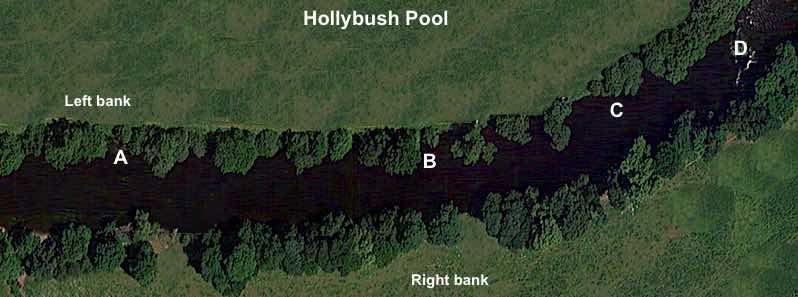
Wet fly fishing the Hollybush Pool:
If fishing the pool with nymphs doesn’t produce any results or my catch rate fades, then I switch to to fishing a team of wet flies or spiders. A reduction in catch rate usually occurs when grayling have started taking flies higher in the water column, which can happen around mid-day due to a surface temperature rise.
When it’s not possible to identify what flies the grayling are feeding, I will start with one of my workhorse team of wet flies /spiders spaced 3ft apart on 3lb copolymer leader, depending on the time of year.
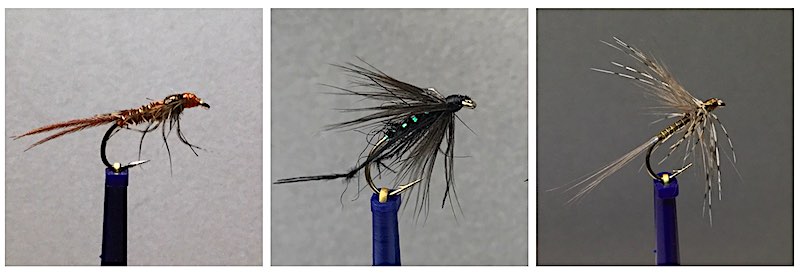

If I haven’t had any takes after ca. 20 minutes, I wil start trying other patterns until success comes. That said, the workhorse teams rarely fail to catch grayling.
My preference is to start fishing the wet fly at the tail of the pool (point D) and slowly fish up to the head of the pool. Typically, I casts the flies upriver at a 45 degree angle and allow them to dead-drift downriver. When the flies drift downstream of me, I mend the line to slow their swing around to the dangle.
Even if fish are rising close to the far bank, it is often wise to resist the temptation to cast directly to them. A better approach is to divide the width of the river into 3ft lanes and search each lane before fishing the lane holding the rising fish.
This approach often yields grayling that you have not seen and that otherwise would have been spooked.
If there is a strong downstream wind, I find it best to start at the head of the pool (point A) and fish the wet flies across and downstream.
Even if you have covered the pool initially with nymphs, it’s definitely worth covering the section of the Hollybush Pool from point B to D with the wet fly. This is becauce it’s posible to cover the section from mid-river to the far bank that can’t be reached with the nymphs.
I have a separate page on Wet Fly fishing that has more information on the approach I find successful.

Dry fly fishing the Hollybush Pool:
Grayling can be tempted to take a dry fly when there’s no sign of surface fly life. This is especially so when they are lying in less than 4ft of water.
When the Welsh Dee is close to its summer level, most of the Hollybush Pool is less than 4ft deep. Therefore, when fishing this part of the pool it’s best to cover likely lies with the dry-fly, before casting to rising grayling.
It’s best to base fly choice on imitating fly that are hatching. However, if this is no possible one of the following will usually catch grayling from October onwards:
Additional reading - Fly selection for the Hollybush Pool Oct to Feb:
If you’re intested in leaning more about the various flies that I find work on the Welsh Dee from October to Febuary then it’s worth reading the following post:
How to fish the Hollybush Pool from March to September
The brown trout fishing season on the Welsh Dee starts on the 3rd March. At this time of year, the weather is often more like winter than spring. Therefore, my approach to brown trout is similar to that described for autumn & winter grayling above.
Once April arrives, the weather usually starts to warm up and hatches of Large Dark Olives, March Brown and other olives become more frequent from mid-morning to mid-afternoon. This provides more opportunities to catch brown trout on the dry fly, by matching the hatch.
As May approaches fly hatches become more prevalent and brown trout are keen to intercept emerging fly life. This is when dry-fly and upstream wet-fly fishing often yield the best results. Unless the river is carrying some colour when Czech (Euro) nymphing generally produces better results
The river flows south through the Hollybush Pool and on sunny days it is too bright to fish this pool from 11 am to 4 pm. Therefore, it’s best fishing this pool early morning and late evening.
On dull, overcast days this pool can be fished throughout the day, but the fishing still slows between 1 and 4 pm. Making this a good time for a break before resuming the challenge in the evening.
In the tail of Hollybush pool the river flow over a rock ledge that forms about 10m of broken water, which provides cover for fish hiding in the gullies and deeper pockets.
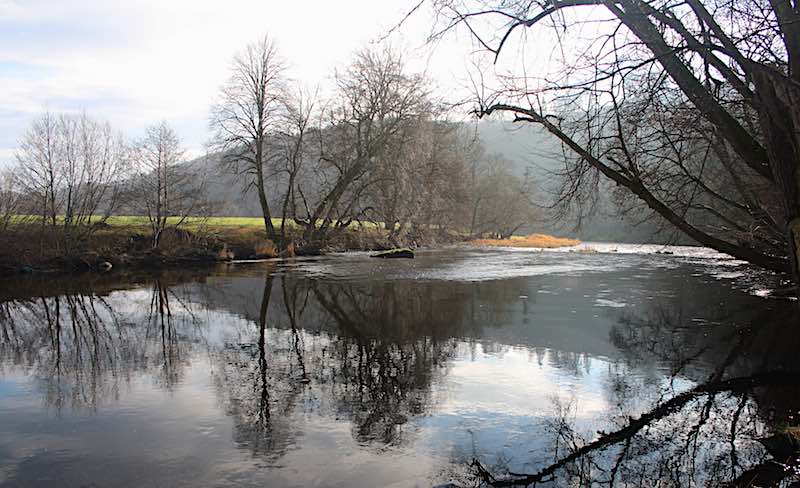
In the summer when the river is low I find most of the fish lie in this part of the pool and I often catch quality trout , grayling and the occassional sea trout using both wet and dry fly fishing techniques.
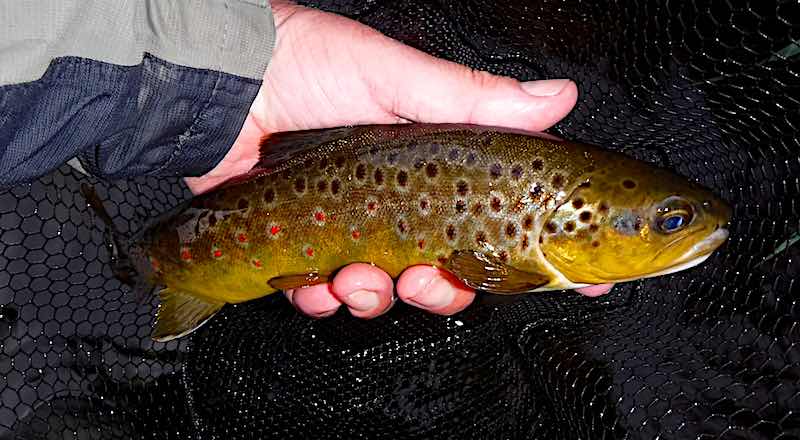
How to fish the Hollybush Pool for sea trout:
The main run of Welsh Dee sea trout start to populate the pools above Llangollen during July and the tail of the Hollybush Pool is sea trout lie.
I only fish the tail of the Hollybush Pool for sea trout with the fly while I can still see what I’m doing because it’s too treacherous to wade there at night (i.e. too many tripping hazards and gullies).
In the tail sea trout lie close to the weedbeds, the rock ledge and under the overhanging trees on far bank; as marked on the following sketck.
To-date, the best way I’ve found to catch sea trout there is by fishing a team of three wet flie / spiders on a floating line tipped with a 9ft tappered leader and 3ft of 3lb copolymer. Attached is the link to the post that covers the flies I use for day-time sea trout fishing.
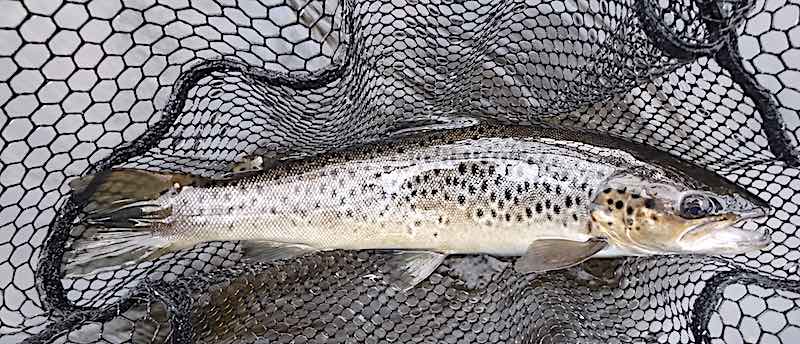
This approach usually produces sea trout in the 1 to 3lbs bracket. In addition, you will are likely to catch a large brown trout or large grayling to a couple of pounds.
How to fish the Hollybush Pool for Salmon:
Almost every year, I fish the tail section of the Hollybush Pool for salmon with the fly and spinner but as yet I’ve not hooked a salmon there.
However, nearly evey year salmon are caught there by others spinning from the left bank. In 2019….
“my son caught a salmon there on the spinner and lost another a couple of cast later”
From September, I mainly fish this pool with the fly from the left bank when the river level below 0.6m. Most of this pool is less than 4ft deep, and thus I use a floating line with a 12ft copolymer tapered leader (12lb tip).
For fly selection I use this simple strategy:
- In clear water I use size 10 or smaller drab coloured fly (e.g. Stoats tail, Blue Charm, etc)
- In coloured water a size 10 or higher brightly coloured fly (e.g. Cascade, Park shrimp etc).
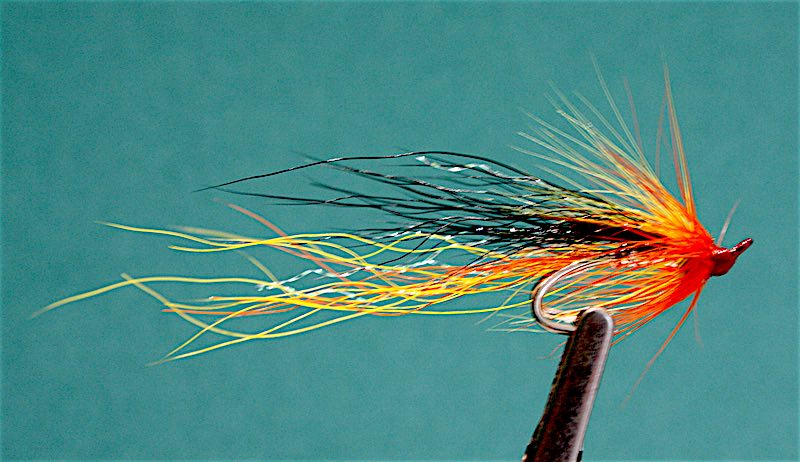
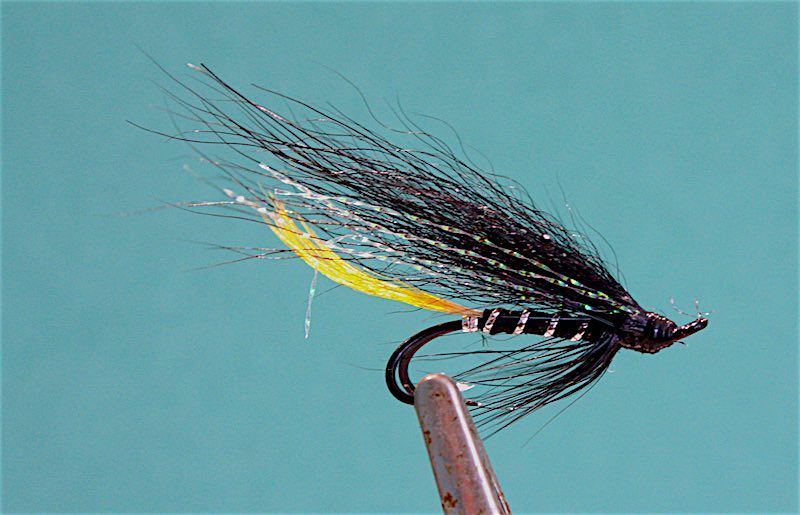
Hopefully, I will catch a salmon from the Hollybush Pool next year and have a picture to post
Directions & Parking to the Hollybush Pool
Take the A5 from Llangollen to Crown. Immediately after the B5103 junction, by Berwyn Station, take the next right. Follow the lane about 500 metres to the lay-by on the left next to the railway tunnel.
The right bank is best accessed by parking in the layby opposite Duncan’s Pool, followed by a 100m walk up river to the tail of the pool. The left bank is best accessed through the marked gate at Llantysillio Church followed by a 10 minute walk up river to just past Duncan’s Pool.
A map to this pool can be found on Llangollen-Maelor Angling website.
Disclaimer:
Like most outdoor sports, fishing is not without its hazards. Therefore, YOU MUST DO YOUR OWN RISK ASSESSMENT before starting to fish the Hollybush Pool. Especially if you decide to wade and/or fish at night. In addition, you must follow the Llangollen-Maelor Club Rules when accessing and fishing this water.
